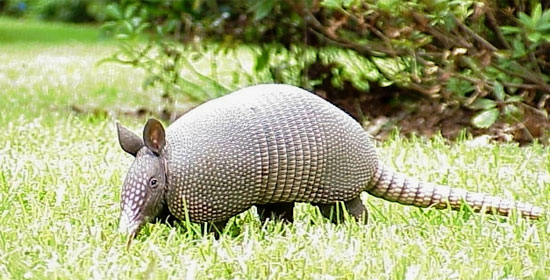Weekend Gardening: Outwit and Outlast Those Troublesome Armadillos
May 21, 2016
by UF/IFAS Extension Service
Have you ever discovered your once beautiful green lawn looking like the surface of the moon, full of craters? If so, then you may have been visited by an alien-looking creature known as the armadillo.
Armadillos originated in South America. They are mammals. They are neither rodents nor marsupials and are not related to the opossum. Their closest living relative is the anteater and sloth.
The most easily recognized feature of an armadillo is its shell. Their common name, armadillo, is derived from a Spanish term meaning “little armored one”. All armadillos have shells, made of true bone, that cover their backs. Most armadillos also have bony rings or plates that protect their tails.
Digging machines
Armadillos are built to dig. They rely on this ability to escape danger and survive. They prefer sandy or loam soils that are relatively easy to excavate. Therefore, they are well adapted to Northwest Florida soils.
Armadillos typically rest in deep burrows during the day and become more active during the late evening, night, or early morning. These burrows are usually located under brushpiles, stumps, dense brush, or concrete patios, and are about 7 to 8 inches in diameter and can be up to 15 feet long. They often have several burrows throughout their territory.
Food sources
Armadillos feed primarily on insects. They also eat earthworms, scorpions, spiders, snails, and small vertebrates and their eggs. They consume large amounts of armyworms, cockroaches, ants, wasps, flies, beetles, and grasshoppers. They have been known to dig up entire yellow-jacket nests.
Some consider the armadillo a beneficial creature because they eat potential pests. Many consider the armadillo a pest because of their destructive ways. Armadillo can burrow under driveways and patios causing structural damage. Burrows in pastures can pose a potential hazard to livestock. And because armadillos usually search for food by rooting or digging in the ground, they can damage large areas of the lawn or garden.
Control measures
If you find that you cannot live with these creatures, the University of Florida recommends four ways to deal with armadillos.
- reducing the amount of water and fertilizer you apply to your lawn
- creating barriers (e.g., fences),
- live-trapping
- shooting offending individuals (check local ordinances)
The best solution (and the most expensive) is a stout fence to keep the armadillos out. If you take this route, make sure the fence is buried at least 18 inches into the ground, or they might just burrow under it.
Reducing the water and fertilizer applications to your lawn may help reduce armadillo damage. A moist lush landscape is perfect for earthworms and insect larvae. Armadillos love earthworms. Sometimes watering adjacent areas may attract armadillos away from a site.
Trapping can be frustrating and may require some ingenious thinking. Some tried and true trapping techniques are discussed at length in an online University of Florida publication by Dr. Russ Mizell at http://ufinsect.ifas.ufl.edu/armadillo.htm.
Remember that poison baits are illegal and ineffective. No chemical repellents or fumigants are registered for use in Florida.
Armadillos are very happy in Northwest Florida and are here to stay. If they have become unwelcomed house guests, put your thinking cap on and be committed to outwitting and outlasting this prehistoric-looking creature.
Courtesy photos for NorthEscambia.com, click to enlarge.
Comments
8 Responses to “Weekend Gardening: Outwit and Outlast Those Troublesome Armadillos”





Armadillos are also easier to trap than most people think. All you have to do is dig a fairly deep hole, set a bucket in it and put a board across the hole that will tilt and allow the Armadillo to fall into the bucket. You can then pick up the bucket and take the fella to an uninhabited area.
Personally, I prefer the Armadillos over having fire ants in the yard. Filling in a few holes a few times a week is tolerable over getting rid of Fire Ants…….One area on our acreage is designated as the family picnic area and I do have flower gardens, lush grass, etc. there, so I put down chicken wire on the dirt before putting the grass sod there……Seems to keep them from digging that area…..
REGARDING:
“Armadillos are known to carry and infect humans with leprosy. The most cases are in Florida! Never touch an Armadillo to keep from getting leprosy from it. If you trap it, don’t touch it. Leprosy can stay in your body a long time before symptoms appear and is a long term infection.”
It is true that they sometimes carry it and good to avoid getting infected, but being infected isn’t the end of the world.
From
http://www.livescience.com/52792-armadillos-leprosy-bacteria-spreading-southern-us.html
“Leprosy — which is usually called by its modern name, Hansen’s disease — is curable with antibiotics, and has a low risk of being spread among people.”
Personally, I found them to be tasty even though I haven’t eaten any since 1976.
I like the fact that they like to eat fire ants and yellow jackets.
(The enemy of my enemy…)
If somebody could train them to dig on command, rotary tiller makers would go out of business.
David for tasty friends
I guess I’m in the minority here. I rather like the little “Snuffles”, they are always welcomed in my yard to get rid of especially mole crickets (which do a lot more damage). Much rather have them than toxic junk most folks use on their lawns, that will eventually come back to poison us. With the leprosy bit..while it’s true it is also very rare, contagion more so from the bare babies, but with all the antibiotics we are prescribed for every little thing nowadays, I wouldn’t worry too much. If ya’ kill it….eat it! They are suppose to be a delicacy, never tried it though. I prefer my “critters” alive.
I don’t have to outlast OR outwit them…all I have to do is outshoot them.
I had trouble with these guys for years, destroying what little lawn I have, till an old man gave me the best advise on keeping them out of your yard. An armadillo can detect food such as worms, 12 inches under the soil, and then digs for it, destroying your yard.
Buy yourself some “Bug Blaster”, sold at all the Feed stores, spread it on your lawn and water it in. It kills the ants, earthworms and all the insects that burrow under your lawn, and therefore eliminates the armadillo’s food. It does not harm your lawn in any way, and It’s not expensive, about $15 a bag that covers 5000 square feet.
I know God created every animal and insect for a purpose, but sometimes I wonder about armadillos, mosquitoes and gnats.
I put deer fencing down flat around the edge of the yard. They get tangled in it and go elsewhere. So far it has worked pretty well. Just FYI. The deer and rabbits can go over it, coyotes seem to get tangled up too, so it seems worth doing for me. Just FYI.
Great article, but it should’ve covered how that Armadillos are known to carry and infect humans with leprosy. The most cases are in Florida! Never touch an Armadillo to keep from getting leprosy from it. If you trap it, don’t touch it. Leprosy can stay in your body a long time before symptoms appear and is a long term infection.